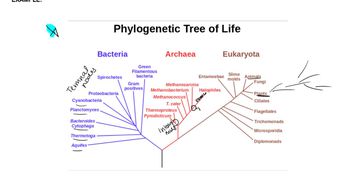Using the following amino acid sequences obtained from different species of apes, construct a phylogenetic tree of the apes.
Table of contents
- 1. Introduction to Genetics51m
- 2. Mendel's Laws of Inheritance3h 37m
- 3. Extensions to Mendelian Inheritance2h 41m
- 4. Genetic Mapping and Linkage2h 28m
- 5. Genetics of Bacteria and Viruses1h 21m
- 6. Chromosomal Variation1h 48m
- 7. DNA and Chromosome Structure56m
- 8. DNA Replication1h 10m
- 9. Mitosis and Meiosis1h 34m
- 10. Transcription1h 0m
- 11. Translation58m
- 12. Gene Regulation in Prokaryotes1h 19m
- 13. Gene Regulation in Eukaryotes44m
- 14. Genetic Control of Development44m
- 15. Genomes and Genomics1h 50m
- 16. Transposable Elements47m
- 17. Mutation, Repair, and Recombination1h 6m
- 18. Molecular Genetic Tools19m
- 19. Cancer Genetics29m
- 20. Quantitative Genetics1h 26m
- 21. Population Genetics50m
- 22. Evolutionary Genetics29m
22. Evolutionary Genetics
Phylogenetic Trees
Problem 24
Textbook Question
Considering the phylogenetic assignment of Plasmodium falciparum, the malarial parasite, to the phylum Apicomplexa, what might you speculate as to whether the parasite is susceptible to aminoglycoside antibiotics?
 Verified step by step guidance
Verified step by step guidance1
Understand the classification of Plasmodium falciparum: It belongs to the phylum Apicomplexa, which consists of eukaryotic organisms. Aminoglycoside antibiotics typically target prokaryotic ribosomes, so this classification is important for determining susceptibility.
Recall the mechanism of action of aminoglycoside antibiotics: These antibiotics bind to the 30S subunit of prokaryotic ribosomes, interfering with protein synthesis. Eukaryotic organisms, like Plasmodium falciparum, have 40S ribosomal subunits, which are structurally different.
Consider the evolutionary relationship: Apicomplexans, including Plasmodium falciparum, are more closely related to other eukaryotes than to prokaryotes. This suggests that their ribosomes are unlikely to be targeted by aminoglycosides.
Evaluate any exceptions: Some eukaryotic organisms have prokaryotic-like ribosomes in their organelles (e.g., mitochondria). Check if Plasmodium falciparum has organelles with ribosomes that could be targeted by aminoglycosides.
Conclude based on the evidence: Given the eukaryotic nature of Plasmodium falciparum and the specificity of aminoglycosides for prokaryotic ribosomes, it is unlikely that the parasite is susceptible to these antibiotics. However, further research into its organelles may provide additional insights.
 Verified video answer for a similar problem:
Verified video answer for a similar problem:This video solution was recommended by our tutors as helpful for the problem above
Video duration:
2mPlay a video:
Was this helpful?
Key Concepts
Here are the essential concepts you must grasp in order to answer the question correctly.
Phylogenetics
Phylogenetics is the study of evolutionary relationships among biological entities, often represented as a tree-like diagram. It helps in understanding how species are related through common ancestry. In the context of Plasmodium falciparum, its classification within the phylum Apicomplexa provides insights into its evolutionary adaptations and potential vulnerabilities to treatments.
Recommended video:
Guided course

Phylogenetic Trees
Apicomplexa
Apicomplexa is a phylum of parasitic protists known for their complex life cycles and specialized structures for host invasion. Members of this group, including Plasmodium falciparum, have unique cellular features that differentiate them from other organisms. Understanding the biology of Apicomplexa is crucial for predicting their susceptibility to various antibiotics, including aminoglycosides.
Aminoglycoside Antibiotics
Aminoglycoside antibiotics are a class of drugs that inhibit bacterial protein synthesis by binding to the 30S ribosomal subunit. They are primarily effective against aerobic Gram-negative bacteria and some Gram-positive bacteria. However, their efficacy against eukaryotic parasites like Plasmodium falciparum is limited due to differences in ribosomal structure and function, suggesting that these antibiotics may not be effective in treating malaria.
Recommended video:
Guided course

R Plasmid
Related Videos
Related Practice
Textbook Question
452
views


